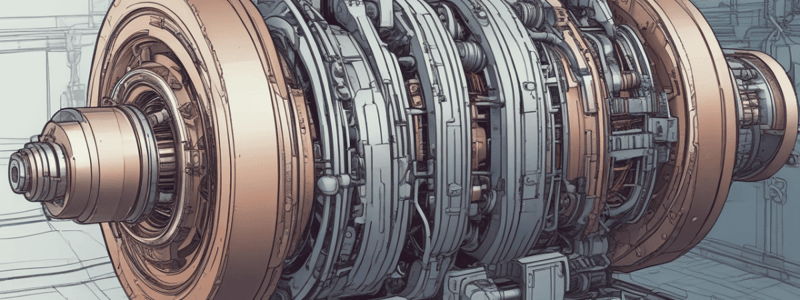Podcast
Questions and Answers
What is the primary consideration when selecting an electric drive for industrial applications?
What is the primary consideration when selecting an electric drive for industrial applications?
- Operating conditions
- Load characteristics
- Duty cycle and environmental factors
- All of the above (correct)
Which class of duty involves operating at a constant speed for an extended period?
Which class of duty involves operating at a constant speed for an extended period?
- Continuous Duty (S1) (correct)
- Intermittent Duty (S3)
- Periodic Duty (S4)
- Short-Time Duty (S2)
What type of electric drive is required for steel mills?
What type of electric drive is required for steel mills?
- Variable frequency drives
- Light-duty electric drives
- Heavy-duty electric drives (correct)
- Special Duty (S5) drives
What is the primary function of Variable Frequency Drives (VFDs) in paper mills?
What is the primary function of Variable Frequency Drives (VFDs) in paper mills?
Which class of duty involves operating at a constant speed for a limited period, followed by a rest period?
Which class of duty involves operating at a constant speed for a limited period, followed by a rest period?
What is the purpose of defining different classes of duty?
What is the purpose of defining different classes of duty?
Which class of duty involves alternating between periods of operation and rest, with different load and speed conditions?
Which class of duty involves alternating between periods of operation and rest, with different load and speed conditions?
What is the characteristic of Special Duty (S5) applications?
What is the characteristic of Special Duty (S5) applications?
Why are VFDs often used in paper mills?
Why are VFDs often used in paper mills?
What is the primary consideration for electric drives in paper mills?
What is the primary consideration for electric drives in paper mills?
What is the characteristic of Periodic Duty (S4) applications?
What is the characteristic of Periodic Duty (S4) applications?
What is the primary purpose of using variable speed drives in cement mills?
What is the primary purpose of using variable speed drives in cement mills?
What is the main requirement for electric drives in textile mills?
What is the main requirement for electric drives in textile mills?
What is the primary consideration for selecting electric drives in sugar mills?
What is the primary consideration for selecting electric drives in sugar mills?
What is the main characteristic of electric traction systems?
What is the main characteristic of electric traction systems?
What is the primary requirement for electric drives in coal mining operations?
What is the primary requirement for electric drives in coal mining operations?
What is the main purpose of electric drives in induction heating systems?
What is the main purpose of electric drives in induction heating systems?
What is the primary consideration for selecting electric drives in surface hardening applications?
What is the primary consideration for selecting electric drives in surface hardening applications?
What is the primary requirement for electric drives in dielectric heating systems?
What is the primary requirement for electric drives in dielectric heating systems?
What is the key factor in selecting electric drives for industrial applications?
What is the key factor in selecting electric drives for industrial applications?
What is essential for ensuring reliable and efficient operation in various industrial settings?
What is essential for ensuring reliable and efficient operation in various industrial settings?
Flashcards are hidden until you start studying
Study Notes
Classes of Duty
- Continuous Duty (S1): Load remains constant and operates at a constant speed for an extended period, examples include fans, pumps, and compressors.
- Short-Time Duty (S2): Load operates at a constant speed for a limited period, followed by a rest period, examples include cranes, lifts, and hoists.
- Intermittent Duty (S3): Load alternates between periods of operation and rest, with different load and speed conditions during each cycle, examples include mixers, conveyors, and machine tools.
- Periodic Duty (S4): Load operates in cycles with regular intervals between each cycle, but the load conditions may vary within each cycle, examples include reciprocating pumps and compressors.
- Special Duty (S5): Category includes specific duty cycles that do not fit into the standard classifications, examples include applications with frequent starts and stops or variable load conditions.
Selection of Electric Drives for Industrial Applications
- Steel Mill: Requires heavy-duty electric drives that can handle high torque and variable loads, suitable for operating rolling mills, conveyors, and other heavy machinery.
- Paper Mill: Requires electric drives with precise speed control for various processes such as pulp processing, paper forming, and cutting, often using variable frequency drives (VFDs).
- Cement Mill: Requires high-torque electric drives to operate crushers, mills, kilns, and conveyors, often using variable speed drives (VSDs) to optimize energy consumption and process efficiency.
- Textile Mill: Requires electric drives that provide accurate speed control and can handle variable loads with frequent starts and stops, suitable for spinning, weaving, and dyeing processes.
- Sugar Mill: Requires robust and reliable electric drives that can handle heavy loads and variable operating conditions, suitable for crushing, milling, and refining processes.
- Electric Traction: Requires high-performance electric drives that can provide variable speed control and regenerative braking, suitable for electric traction systems such as trains and trams.
- Coal Mining: Requires rugged and reliable electric drives that can withstand harsh environmental conditions, suitable for various applications including conveyor systems, crushers, and pumps.
Specialized Applications
- Induction Heating: Requires high-frequency electric drives to generate alternating magnetic fields for heating metallic objects, with precise control over power and frequency.
- Surface Hardening: Requires electric drives that provide precise control over heating patterns and temperatures to achieve uniform hardening of metal surfaces.
- Dielectric Heating: Requires electric drives that generate high-frequency electromagnetic fields for heating dielectric materials, with precise control over power and frequency to optimize heating efficiency and product quality.
Studying That Suits You
Use AI to generate personalized quizzes and flashcards to suit your learning preferences.




